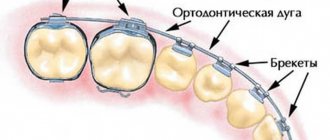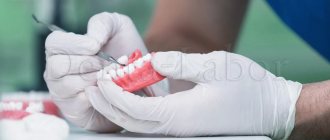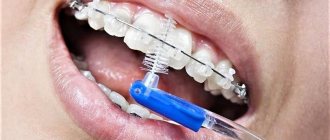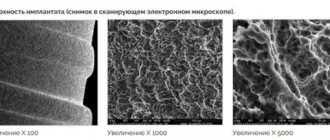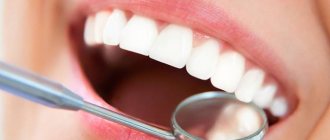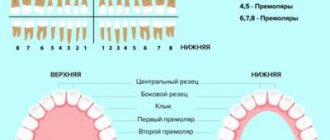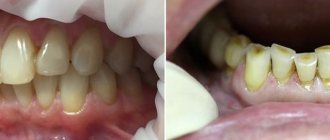Nowadays, beautiful, straight teeth are not a luxury, but a necessity, because they are one of the integral components of the image of a successful person. One way to achieve the desired effect is to restore the crown of the tooth. They resort to it not only because of aesthetics, but also because of the functionality of the dentition, when their restoration is required due to destruction, severe abrasion or anatomical features.
The coronal part of the tooth is the supragingival part of the tooth, covered with enamel and passing into the root through the neck of the tooth. Modern dentists distinguish the anatomical and clinical parts of the crown: the first is the area where the enamel transitions into periodontal cement, the second is designated by the attachment of gingival tissue. Lengthening the clinical crown of a tooth involves performing the procedure on periodontal tissues. Thanks to it, the crown part becomes longer, which allows you to achieve the desired aesthetic effect.
When is it necessary to lengthen a dental crown?
Indications for the procedure can be divided into three categories:
- Restorative - lengthening is carried out to restore the anterior dental crown due to a chip and involves the use of veneers or fillings that allow you to restore the length;
- Aesthetic – the need to lengthen the tooth crown arises due to cosmetic defects. These include a discrepancy between the teeth and gums, in which the teeth look small, but when you smile, a large amount of gum opens;
- Functional - the need for lengthening is due to severe wear of teeth due to congenital characteristics, due to frequent stress or bad habits.
In our clinic you can get a free dental consultation!
Complex treatment was performed by Dial-Dent specialists:
- Orthopedic dentist – planning and coordination of complex treatment, dental prosthetics.
- Periodontist surgeon – surgical lengthening of tooth crowns.
- Dentist-endodontist – treatment of tooth canals under a microscope.
- Dental technician - making ceramic crowns.
- Dental assistants.
See other examples of the work of Dial-Dent specialists here.
Make an appointment for a consultation by phone +7-499-110-18-04 or through the form on the website. You can ask questions about dental prosthetics to the chief doctor of the clinic, Sergei Vladimirovich Tsukor, at
Our doctors
18 years of experience
Baghdasaryan
Armen Evgenievich
Chief physician, dentist-orthopedist-therapist
Graduated from VSMA named after. N.N. Burdenko. Internship on the basis of MGMSU named after. A.E. Evdokimov in “General Dentistry”.
Clinical residency at the Moscow State Medical University named after. A.E. Evdokimov in “Orthopedics”.
More about the doctor...
5 years experience
Sadina
Ekaterina Vladislavovna
Dental therapist, surgeon
Penza State University Medical Institute, specialty “Dentistry”.
In 2016, she underwent professional retraining in the specialty “Therapeutic Dentistry” at the Moscow State Medical and Dental University named after A.I. Evdokimov.
More about the doctor...
8 years of experience
Arzumanov
Andranik Arkadievich
Dentist-orthodontist
Graduated from Moscow State Medical University. Internship - Moscow State Medical University at the Department of Orthodontics and Children's Prosthetics.
Residency at Moscow State Medical University at the Department of Orthodontics and Children's Prosthetics. Member of the Professional Society of Orthodontists of Russia since 2010.
More about the doctor...
Parameters of the ideal ratio of gum and tooth crown
Modern dentists have developed parameters that determine the correct relationship between gums and dental crowns, which determines the beauty of a smile. Their main provisions are as follows:
- The gingival contour on the lateral incisors should be equally spaced and located slightly lower than on the central ones;
- The alveolar process is not visible when smiling;
- The gum contour corresponds to the smile line;
- The height of the clinical crowns of the central incisors cannot be less than 11 mm.
If at least one parameter does not correspond to the above, the smile does not look attractive.
The main stages of the teeth extension procedure
The tactics chosen by the dentist when extending teeth directly depend on the degree of destruction of the dental crown.
Partial tooth damage
In cases where only partial damage is detected on its surface (small chips, cracks, thinning of the enamel), as well as when there is a need to eliminate wide gaps between adjacent teeth, the tooth is restored with composite materials.
Severe damage
In cases where the tooth is too damaged, extensions are made by implanting a pin into the tooth root and applying composite materials to form the tooth.
Stage 1 – professional teeth cleaning
At the first stage of treatment, the patient undergoes professional teeth cleaning, dental tissues affected by caries are removed and the canals are treated.
Stage 2 – application of reflective material and polishing
After this, a light-curing material is applied layer by layer to the remaining tooth tissue (or to the pin), and each portion of it is illuminated with a special lamp. After restoration of damaged tissues, the extended area is grinded and polished using paste and special brushes.
In most cases, tooth augmentation is carried out using the direct method, that is, all activities related to the restoration of dental crowns are carried out directly in the oral cavity of the client of the dental clinic.
Moreover, to restore a tooth, only one visit to the doctor is required.
Indirect restoration is performed only in situations where there is a need to manufacture additional orthopedic structures (pins, inlays) in a dental laboratory.
What methods are used for lengthening?
Modern dentistry offers various techniques for lengthening the crown of a tooth. Their selection is carried out on an individual basis depending on the patient’s indications.
| Method | Indications for use | How is it carried out? |
| Orthodontic | It is necessary to lengthen the crown of one tooth | Involves the use of braces, which must be worn for at least two years. |
| Orthopedic | Weared cutting edges of crowns, significant defects of decayed teeth, short teeth with the correct gingival contour. | It consists of building up with the use of veneers or crowns, which as a result raises the bite without involving the gingival area in the process. |
| Therapeutic | Chip of one tooth. | Provides for the restoration of the coronal part of the tooth by increasing the cutting edge using special composite materials. |
| Surgical | Gummy smile, the need to raise the gum level and give it the desired line. | An operation is performed to remove part of the bone and gum tissue and form the gingival contour of the desired shape. Depending on the clinical indications, bone resection, gingivoplasty or gingivectomy are performed. |
Possible consequences
Despite the external harmlessness of the anomaly, it can lead to severe impairments of many functions of the dentofacial apparatus and the body as a whole:
- In the absence of correction, pronunciation violations . Most often, the pronunciation of the sounds of hissing and whistling sounds is impaired.
- Pathology provokes the formation of abnormal breathing .
A long period without treatment leads to the consolidation of stable mouth breathing, which in the future will be difficult to stop. Also, as a result of this, frequent inflammations of the ENT organs may develop. - Incorrect relationship of the cutting part of the teeth is the cause gastrointestinal diseaseswhich develop due to inadequate chewing of food.
A severe anomaly can cause frequent headaches, which arise due to displacement of the joint and compression of the neurovascular bundle.This phenomenon is often accompanied by spasms, aching joints and can cause vascular dysfunction.
- When teeth are deformed or incorrectly positioned, the quality of oral cleaning deteriorates, which leads to carious lesions .
- In addition, an abnormal bite develops in a person a feeling of inferiority , as a result of which he acquires psychological trauma.
What factors need to be considered when surgically lengthening a tooth crown?
Surgical intervention aimed at correction in the frontal region must be carried out perfectly, since any mistake will lead to noticeable cosmetic defects. In addition, it is important to exclude any effect of the operation on the stability of the tooth.
That is why surgical lengthening of the crown of a tooth is preceded by careful preparation. The patient must undergo a series of diagnostic tests, which includes examinations by a periodontist, an orthopedist and a surgeon, as well as a 3D computed tomography scan. The latter is necessary in order to determine the length at which the tooth roots are located and to assess the condition of the jaw bone tissue.
When planning an operation, the following factors are taken into account:
- The current state of periodontal tissues, the forecast of their condition for the future;
- The distance between the bottom of the gingival sulcus and the bone crest: it must exceed 3 mm in order to guarantee the stability of the tooth;
- Aesthetic component;
- Anatomical features of the anatomy of dental roots, the ratio of the length of the coronal and root parts: the root part cannot be smaller than the coronal part;
- Condition of the jaw bone.
Are there any contraindications to lengthening?
Sometimes, after diagnostic tests, the dentist recommends that the patient refuse the procedure. This happens in the following cases:
- The operation may negatively affect the aesthetics and functionality of adjacent teeth;
- The efforts and material costs for lengthening do not correspond to the predicted result and are not in favor of saving the tooth;
- Restoring a tooth is impossible even if surgery is performed to lengthen it;
- The distance between the bottom of the gingival groove and the bone crest is less than 3 mm;
- The root of the tooth, the crown of which the patient wishes to lengthen, is not long enough.
Diagnostics
To identify an anomaly and the degree of its severity, several standard diagnostic methods :
- visual examination and questioning of the patient, which allows you to create a preliminary clinical picture;
- anthropometric analysis. It is a method of studying the length of the dentition in relation to the sum of all teeth.
This analysis is carried out with preliminary taking of impressions from the patient’s jaw. Working plaster models are made from them, from which the length of the jaw arch is measured using a compass and a special thread.The obtained data are correlated with the norm table, and a conclusion is drawn about the presence and degree of anomaly;
- orthopantomography . This method allows you to view the condition of the jaw tissues and the condition of the root system of all teeth;
- radiography . They are used if it is necessary to study a localized area, since the capabilities of this method are limited to covering 2–3 teeth and no more.
How is tooth crown lengthening surgery performed?
Most often, surgical intervention aimed at lengthening the crown of a tooth involves gingivoplasty. This technique involves excision of part of the gum, which is carried out along the gingival contour. If necessary, the surgeon can also remove part of the bone.
The operation is performed in a surgical dental office using sedation or local anesthesia. Before it is carried out, in addition to diagnosis, the oral cavity is sanitized. The stages of the operation itself include the following:
- Resection of bone tissue;
- Detachment of the mucosa and osteotomy;
- Creation of a new gum contour;
- Suturing the wound and applying a bandage.
Postoperative recommendations
After the teeth lengthening procedure, the following recommendations should be followed:
- follow all doctor's instructions to prevent infection;
- Avoid spicy, sour, solid foods that can irritate or injure tissue;
- stop smoking;
- do not overheat in the sun, in a bath or sauna, postpone taking hot baths;
- minimize heavy physical activity;
- perform oral hygiene with caution;
- treat the oral cavity with antiseptics.
How is the rehabilitation going?
In order to avoid complications and recover as quickly as possible, the patient must strictly follow the recommendations of the attending physician. He needs to rinse with an antiseptic and take antibiotics and pharmacological painkillers. In the first days, you need to minimize physical and chewing stress.
The sutures are removed after about a week. After the wound has healed, temporary prosthetics or restoration are performed, which are replaced with a permanent one after a few months. Complete restoration of the gum edge occurs in one to three years.


